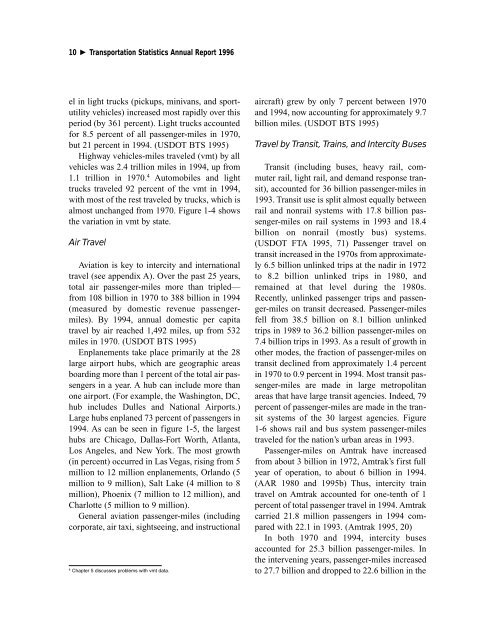table of contents - Research and Innovative Technology ...
table of contents - Research and Innovative Technology ...
table of contents - Research and Innovative Technology ...
Create successful ePaper yourself
Turn your PDF publications into a flip-book with our unique Google optimized e-Paper software.
10 � Transportation Statistics Annual Report 1996<br />
el in light trucks (pickups, minivans, <strong>and</strong> sportutility<br />
vehicles) increased most rapidly over this<br />
period (by 361 percent). Light trucks accounted<br />
for 8.5 percent <strong>of</strong> all passenger-miles in 1970,<br />
but 21 percent in 1994. (USDOT BTS 1995)<br />
Highway vehicles-miles traveled (vmt) by all<br />
vehicles was 2.4 trillion miles in 1994, up from<br />
1.1 trillion in 1970. 4 Automobiles <strong>and</strong> light<br />
trucks traveled 92 percent <strong>of</strong> the vmt in 1994,<br />
with most <strong>of</strong> the rest traveled by trucks, which is<br />
almost unchanged from 1970. Figure 1-4 shows<br />
the variation in vmt by state.<br />
Air Travel<br />
Aviation is key to intercity <strong>and</strong> international<br />
travel (see appendix A). Over the past 25 years,<br />
total air passenger-miles more than tripled—<br />
from 108 billion in 1970 to 388 billion in 1994<br />
(measured by domestic revenue passengermiles).<br />
By 1994, annual domestic per capita<br />
travel by air reached 1,492 miles, up from 532<br />
miles in 1970. (USDOT BTS 1995)<br />
Enplanements take place primarily at the 28<br />
large airport hubs, which are geographic areas<br />
boarding more than 1 percent <strong>of</strong> the total air passengers<br />
in a year. A hub can include more than<br />
one airport. (For example, the Washington, DC,<br />
hub includes Dulles <strong>and</strong> National Airports.)<br />
Large hubs enplaned 73 percent <strong>of</strong> passengers in<br />
1994. As can be seen in figure 1-5, the largest<br />
hubs are Chicago, Dallas-Fort Worth, Atlanta,<br />
Los Angeles, <strong>and</strong> New York. The most growth<br />
(in percent) occurred in Las Vegas, rising from 5<br />
million to 12 million enplanements, Orl<strong>and</strong>o (5<br />
million to 9 million), Salt Lake (4 million to 8<br />
million), Phoenix (7 million to 12 million), <strong>and</strong><br />
Charlotte (5 million to 9 million).<br />
General aviation passenger-miles (including<br />
corporate, air taxi, sightseeing, <strong>and</strong> instructional<br />
4 Chapter 5 discusses problems with vmt data.<br />
aircraft) grew by only 7 percent between 1970<br />
<strong>and</strong> 1994, now accounting for approximately 9.7<br />
billion miles. (USDOT BTS 1995)<br />
Travel by Transit, Trains, <strong>and</strong> Intercity Buses<br />
Transit (including buses, heavy rail, commuter<br />
rail, light rail, <strong>and</strong> dem<strong>and</strong> response transit),<br />
accounted for 36 billion passenger-miles in<br />
1993. Transit use is split almost equally between<br />
rail <strong>and</strong> nonrail systems with 17.8 billion passenger-miles<br />
on rail systems in 1993 <strong>and</strong> 18.4<br />
billion on nonrail (mostly bus) systems.<br />
(USDOT FTA 1995, 71) Passenger travel on<br />
transit increased in the 1970s from approximately<br />
6.5 billion unlinked trips at the nadir in 1972<br />
to 8.2 billion unlinked trips in 1980, <strong>and</strong><br />
remained at that level during the 1980s.<br />
Recently, unlinked passenger trips <strong>and</strong> passenger-miles<br />
on transit decreased. Passenger-miles<br />
fell from 38.5 billion on 8.1 billion unlinked<br />
trips in 1989 to 36.2 billion passenger-miles on<br />
7.4 billion trips in 1993. As a result <strong>of</strong> growth in<br />
other modes, the fraction <strong>of</strong> passenger-miles on<br />
transit declined from approximately 1.4 percent<br />
in 1970 to 0.9 percent in 1994. Most transit passenger-miles<br />
are made in large metropolitan<br />
areas that have large transit agencies. Indeed, 79<br />
percent <strong>of</strong> passenger-miles are made in the transit<br />
systems <strong>of</strong> the 30 largest agencies. Figure<br />
1-6 shows rail <strong>and</strong> bus system passenger-miles<br />
traveled for the nation’s urban areas in 1993.<br />
Passenger-miles on Amtrak have increased<br />
from about 3 billion in 1972, Amtrak’s first full<br />
year <strong>of</strong> operation, to about 6 billion in 1994.<br />
(AAR 1980 <strong>and</strong> 1995b) Thus, intercity train<br />
travel on Amtrak accounted for one-tenth <strong>of</strong> 1<br />
percent <strong>of</strong> total passenger travel in 1994. Amtrak<br />
carried 21.8 million passengers in 1994 compared<br />
with 22.1 in 1993. (Amtrak 1995, 20)<br />
In both 1970 <strong>and</strong> 1994, intercity buses<br />
accounted for 25.3 billion passenger-miles. In<br />
the intervening years, passenger-miles increased<br />
to 27.7 billion <strong>and</strong> dropped to 22.6 billion in the

















